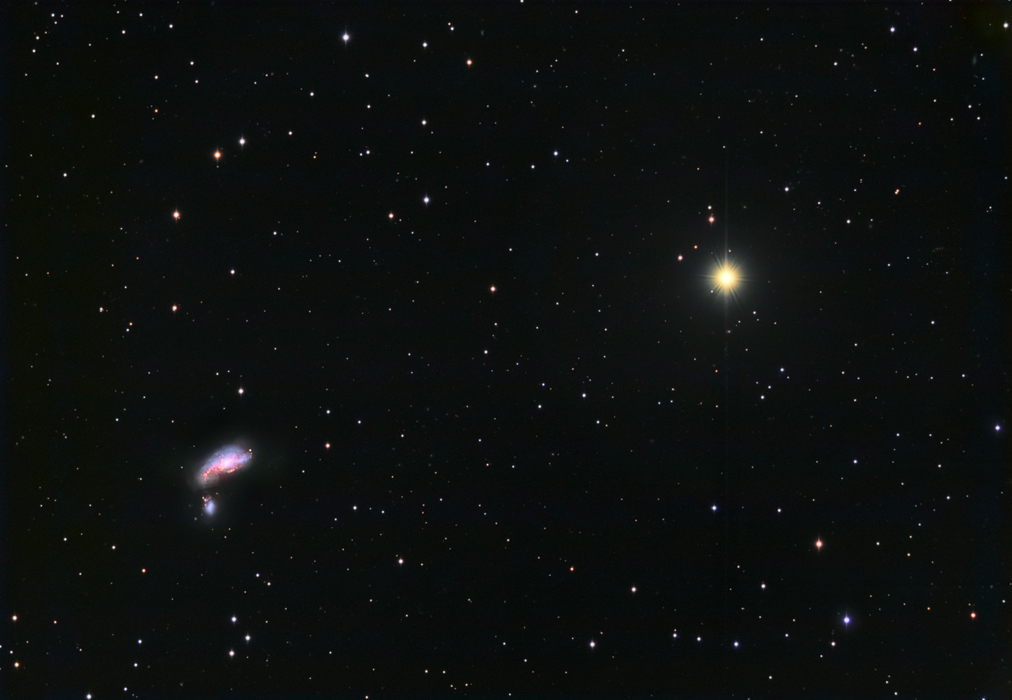Beta Canum Venaticorum (Chara) and the Cocoon Galaxy (NGC
4490)
Characteristics:
Magnitude: 4.21 (Beta CVN)
Size: 6.7 arcminutes (Cocoon Galaxy)
Distance: 27 light years (Beta CVN); 40-50 million light years (Cocoon
Galaxy)
RA: 12h 30m 36s
Dec: 41 degrees 37' 59"
Description:
Beta Canum Venaticorum, aka Chara (Greek for "joy"), is the bright
yellowish star to the right of center. At 27 light years away, it
is a close stellar neighbor with many similarities to our own
sun: 1) it is a G0V main sequence star (click here for a
discussion of stellar evolution), 2) its radius is only 4% larger than
our sun, 3) it has a similar rotation rate (27 days), 4) it is at least
5 billion years old, and 5) it is
single (as opposed to double or triple star systems, which do not allow
the formation of stable planetary orbits). There are a few
differences compared to our sun, including a luminosity that is about
25% greater, and a slightly lower metallicity content (about 60% that
of the sun). However, the presence of metals including iron
suggests that it evolved from a protostellar disk that could support
the formation of rocky planets similar to Earth. Its G0V location
on the main sequence also suggests that it has a similar habitable zone
to our own (i.e., a zone that could support the presence of liquid
water). All of these features make Beta CVN a reasonable
candidate star that could support life (at least life as we know
it). An analysis of Beta CVN, as well as other stars that could
potentially support the formation of life-bearing planets, has been
conducted by Maggie Turnbull, post-doctoral research associate at the
Department of Terrestrial Magnestism, Carnegie Institution of
Washington. A
recent NPR interview on this topic may be found here.
A nice bonus in this image is the presence of the Cocoon Galaxy, which
is undergoing collision with a smaller, spiral galactic partner.
More information about this interesting pair of galaxies may be found here.
Photographic
Details:
Date: March 27, 2006
Scope: Takahashi
FS102 at f6, on the G11 Losmandy
Mount.
Autoguider: SBIG STV with
e-finder.
Camera: Maxcam CM10.
Filter: Astronomik
RGB type II filter set; IDAS LPS filter.
Exposures: LRGB composite.
36 x 4' for luminance (unbinned); 7 x 5' each for R, G, and B
(unbinned); 10 x 30 seconds each for R, G, B (unbinned) to obtain color
for Beta CVN.
Conditions: Temperature 50 degrees F at the start of
imaging, dropping to 32 degrees 4 hours later; good
transparency; average seeing; calm.
Post-processing: Debloomed with Ron Wodaski's
Debloomer software, Calibrated and aligned in Maxim, Sigma combined
using RC Sigma Reject
MaximDL, followed by DDP
in ImagesPlus (IP). Levels,
curves, high-pass sharpening in Photoshop CS (16
bit format).
Please
note: Graphics on this website may not be reproduced without
author permission.
Back to Galaxies
Home

